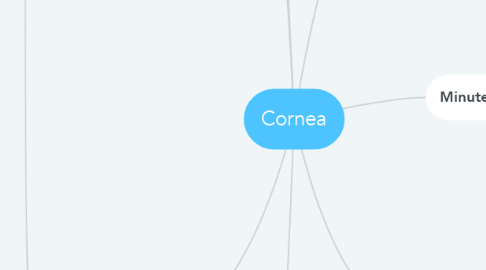
1. Nerve Supply
1.1. * 2 long cilliary nerves from nasocilliary *Pirces sclera 2 times *Cornea sensitive to Pain,Cold and touch *Less pain threshold *Supplies Cornea,Iris,CB, 2-4 ml of CONJ
2. Nutrition
2.1. 1- Limbal capillary 2- Tear film "Aerobic-ATP" 3- aqueous humor (G)
3. Limbus"Corneosclerral junction
3.1. Epithelium
3.1.1. forms 20 layer of CONJ
3.2. Bowmen's memb
3.2.1. sudden disappear about 1mm with round end
3.3. Stroma
3.3.1. Continue as sclera with loss of collagen bundle regularity
3.4. Decement memb
3.4.1. Ends roundly forms schwlble line to continue as TMW which has angle of phontana
3.5. Endothelium
3.5.1. Continue with Endo of Angle and iris
4. Keratitis
4.1. Non Ulcerative keratitis
4.2. Ulcerative Keratitis: Corneal Ulcer
4.2.1. Defi
4.2.1.1. It's loss of continuity of epithelium with bowmen's affection
4.2.2. AE
4.2.2.1. General
4.2.2.1.1. Disease as DM
4.2.2.1.2. Drug as CS
4.2.2.1.3. Nutrition in malnutrition
4.2.2.2. Local
4.2.2.2.1. Epithelium : loss of intact Epi
4.2.2.2.2. Dry eye
4.2.2.2.3. Lagophthalmous
4.2.2.2.4. Corneal sensation loss
4.2.2.3. CO
4.2.2.3.1. *BAC as pneumococci and pseudomonos aeurogenosa *Viral:HZV *Fungal: Candidia *Protozoa: Acanthamebia
4.2.2.4. MT
4.2.2.4.1. *Blephritis
4.2.2.4.2. Conjunctitis
4.2.2.4.3. Dacrocystitis
4.2.2.4.4. Contact lens
4.2.2.4.5. Skin of face
4.2.3. Pathology
4.2.3.1. I-Infltration
4.2.3.1.1. *PMNLs+Injected BVs + Toxin
4.2.3.1.2. Clincal : Gray patch Ciliary injection
4.2.3.2. II-Ulceration
4.2.3.2.1. Early
4.2.3.2.2. Late
4.2.3.3. III-Healing
4.2.3.3.1. Epithelialization
4.2.3.3.2. Vascularized fibrous tissue formation
4.2.4. Clincal Picture
4.2.4.1. Signs
4.2.4.1.1. Pain"pricking",Lacrimation,Belpharospasm,Diminution of vision, Photophobia, Colored haloes.
4.2.4.2. Symptoms
4.2.4.2.1. LID
4.2.4.2.2. CONJ
4.2.4.2.3. CORNEA
4.2.4.2.4. IRIS
4.2.4.2.5. Perforation
4.2.5. Complications
4.2.5.1. NON-Perforating Ulcer
4.2.5.1.1. Early "Unclear ulcer"
4.2.5.1.2. Late Clear Ulcer"
4.2.5.2. Perforating Ulcer
4.2.5.2.1. Prepheral
4.2.5.2.2. Central
4.2.6. Mangment
4.2.6.1. Local
4.2.6.1.1. AB OiEN
4.2.6.1.2. Cycloplegic eyedrops
4.2.6.1.3. Bandadge
4.2.6.1.4. Hot fomentation
4.2.6.2. General
4.2.6.2.1. Systemic ABs
4.2.6.2.2. NSAIDs
4.2.6.2.3. Vitms
4.2.6.3. Causal
4.2.6.3.1. ttt of PF as DM control
4.2.6.4. Resistant
4.2.6.5. ttt of complication
5. Gross Anatomy
5.1. Diameter
5.1.1. 11*12
5.2. Thickness
5.2.1. 550-600micron
5.3. Radius of curvture
5.3.1. *Ant 8mm *Post 7.5mm
5.4. RI
5.4.1. 1.37
5.5. RP
5.5.1. 42-45 D
6. Minute Anatomy
6.1. Epithelium
6.1.1. Non keratinzed with high regenerative power within 24 hours
6.2. Bowmen's membrane
6.2.1. Weak Acellular non regenerative memb
6.3. Stroma
6.3.1. 90% of corneal thickness formed of regular arranged 200-250 lamella of collagen fibers which condensed centrally and separated prepherally.
6.4. Desement membrane
6.4.1. *seperated from stroma by the line of demarcation. *Strong membrane regenerated from endothelial lining it.
6.5. Endothelium
6.5.1. *Single layer of flate cell which can't regenerate but increase in size. *No"3000-4000 /mm2 if reach 400/mm2 corneal edema occurs
7. Physiology
7.1. Corneal transperancy
7.1.1. Anatomical
7.1.1.1. Epithelium non keratized
7.1.1.2. Stroma regular arranged
7.1.1.3. Nerves non-mylinated
7.1.1.4. Bvs not present
7.1.1.5. Tear Film correct any surface irregularities
7.1.2. physilogical
7.1.2.1. Corneal dehydration by endothelial pump
